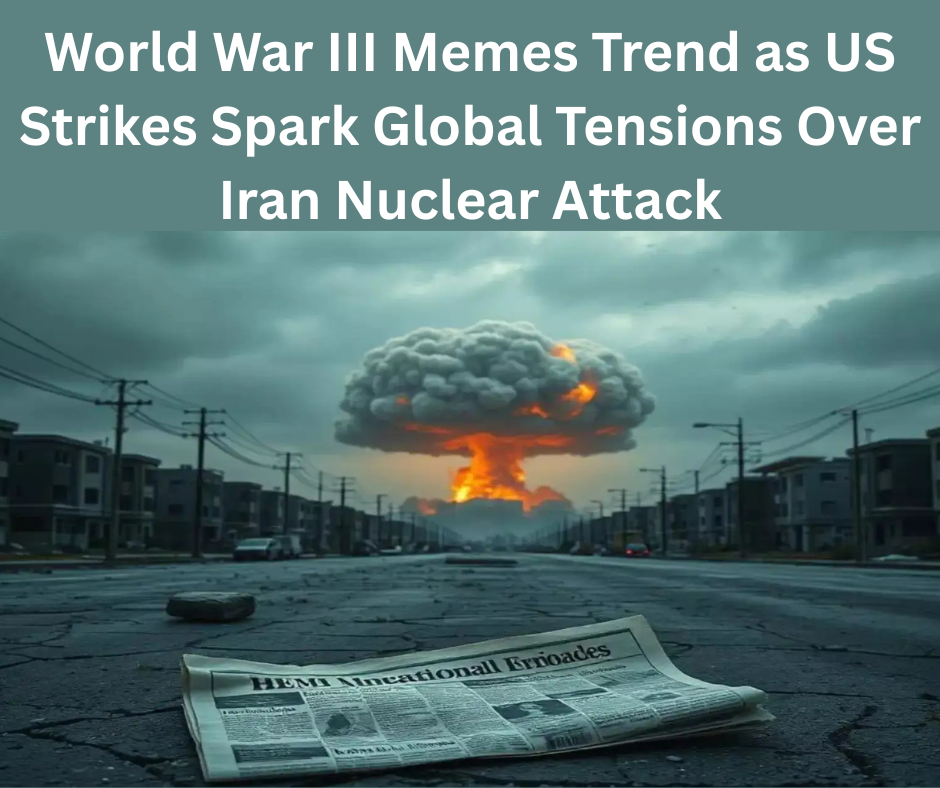World War III Memes
World War III Memes Go Viral After US-Iran Conflict Escalates
As geopolitical tensions rise between the United States, Israel, and Iran, a surprising digital trend has taken over social media platforms—World War III memes. This unexpected wave of humor has become a widespread coping mechanism for internet users, especially Gen Z, who are navigating the anxiety surrounding potential global conflict in the most modern way possible—through memes.
Social Media Reacts with a Flood of World War III Memes
Soon after the United States carried out airstrikes on Iran’s nuclear facilities in Fordow, Natanz, and Isfahan, “World War III” began trending across platforms like X (formerly Twitter), Instagram, TikTok, and Reddit. Alongside serious discussions about the implications of the strikes, a tsunami of World War III memes surfaced, giving the world a satirical lens through which to process the escalating crisis.
From jokes about being drafted into war to parodies of doomsday survival tactics, the internet is buzzing with content that transforms fear into fun. Social users are not ignoring the gravity of the situation—but rather reframing it in a way that makes it bearable. As dark as the topic is, these memes reflect a global need to lighten the emotional load.
Why Are World War III Memes So Popular?
Humor has long been a defense mechanism during troubled times, and World War III memes are simply the latest evolution. These memes serve a dual purpose: they inform and they entertain. With the internet acting as a real-time reflection of public sentiment, the meme boom offers insight into how younger generations are choosing to engage with world events.
Gen Z, in particular, is known for using humor to cope with stress and uncertainty. In the face of what could be a devastating global conflict, World War III memes provide an outlet for collective anxiety. Whether it’s a picture of someone baking bread to distract themselves or a joke about updating LinkedIn while bombs drop, these posts offer comic relief in a tense world.
From Satire to Sarcasm: Top World War III Memes Making Rounds
Here are a few meme formats currently dominating social media:
- “Me packing my bags for WWIII like it’s a weekend getaway.”
- “World War III starting? Better get boba while I still can.”
- “Trying to dodge WWIII like it’s my ex at a party.”
- “Draft notice received. Guess I’ll finally leave the house.”
These memes blend cultural references with global headlines to produce viral humor. The format might be funny, but the underlying message is deeply rooted in real-world fears.
The Role of Memes in Modern Conflict
While World War III memes may seem like mere jokes, experts argue that they play a larger role in public discourse. Memes help simplify complex news events, making them accessible to younger audiences who may not engage with traditional media. They also humanize global events, making distant conflicts feel more immediate and relatable.
Interestingly, memes also serve as a form of peaceful resistance. In a world of misinformation, satire becomes a way to question authority and challenge narratives. Through humor, people are finding their voice—and their tribe—online.
Not Everyone Finds It Funny
Despite the popularity of World War III memes, not all reactions have been positive. Critics argue that trivializing war through humor can be insensitive to those directly affected. They point out that while some are laughing behind screens, others are facing the very real threat of violence and displacement.
Moreover, the viral spread of such content can sometimes blur the line between satire and misinformation. There is a risk that younger audiences might treat memes as news, leading to confusion or underestimation of the situation’s severity.
Memes in the Era of Digital Warfare
The rise of World War III memes also underscores the shift in how people process geopolitical events. In previous decades, major wars were covered with solemn headlines and radio broadcasts. Today, they’re shared as punchlines and GIFs. This doesn’t necessarily mean people care less—it may just reflect the emotional overload and information saturation that characterize our digital age.
Memes now form a critical part of what analysts call “memetic warfare”—the use of viral content to influence perception, sentiment, and morale. While governments deploy military assets, the public fights with memes, wielding humor as both shield and sword.
Final Thoughts: Humor in a Time of Uncertainty
The explosion of World War III memes following the US strikes on Iran highlights how digital culture is shaping our response to international crises. These memes are not just jokes; they are emotional outlets, tools of resistance, and snapshots of global sentiment.
Whether viewed as inappropriate or necessary, World War III memes demonstrate the internet’s power to transform fear into laughter. As world leaders decide the fate of nations, the people are busy turning anxiety into art—one meme at a time.
Read more: US Involvement in Israel-Iran Conflict

[…] Air Balloon Crash in Brazil Leaves 8 Dead: Tragic Incident Sparks Nationwide Mourning World War III Memes Trend as US Strikes Spark Global Tensions Over Iran Nuclear Attack B-2 Stealth Bombers Strike Iranian Nuclear Sites: Key Facts About the US Air Force’s […]